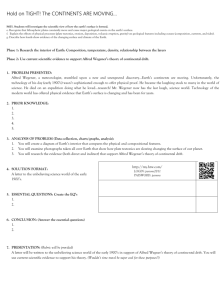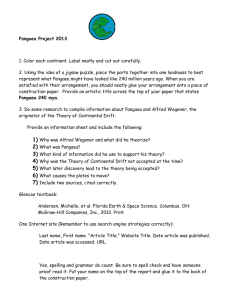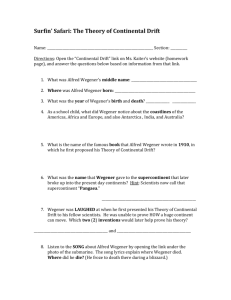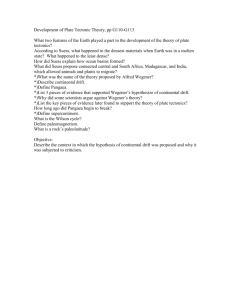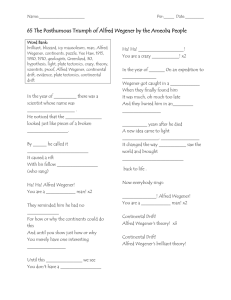File
advertisement
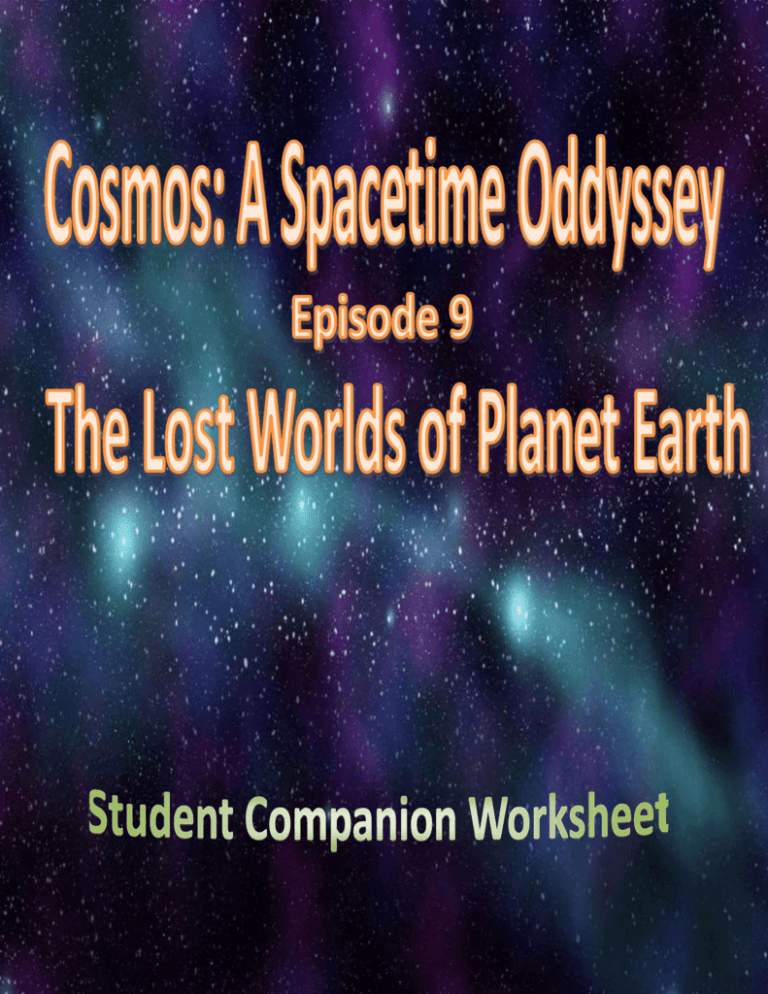
Name:________________________________________________Date:________________Period:_________ Name:________________________________________________Date:________________Period:_________ Cosmos Episode 9: The Lost Worlds of Planet Earth Topics: Geology, Pangaea, Continental Drift and Evolution 1. Why were insects able to grow much larger than they do today? 2. What type of life changed the earth so dramatically? 3. What is the waste product of trees? 4. What did Carbon Dioxide do the climate? 5. What did the dead trees turn into? 6. What type of life flourishes in brutal environments? 7. The Guadalupe Mountain Chain is the worlds largest what? 8. Until about 220 million years ago New England and North Africa were what? 9. What was Abraham Ortelius the first to recognize? 10. What did Alfred Wegener hypothesize? 11. What did Alfred Wegener Name the Supercontinent? 12. What happened to Alfred Wegener a day after his 50th Birthday? 13. What did Marie Tharp find at the bottom of the Atlantic? 14. What is the deepest canyon on earth? 15. Species at the bottom of the ocean can produce light in a process known as what? 16. The Triassic extinction offered an opportunity for which animal group? 17. What have Venus and Jupiter done to the Earth’s axis? 18. When did our current climate age begin? 19. How long should this current warm period last? 20. When will the continents unite again? Name:________________________________________________Date:________________Period:_________ Analysis: Why do you think mammals were able to survive the Triassic Extinction while dinosaurs died out? Many scientists feel that climate change is the most important issue facing the world today. If the world gets to hot, ice caps melt and flooding occurs, if it gets to cold, we could enter a new ice age. Research how scientists hope to limit climate change in the future and explain some of the ideas that seem especially interesting to you. Name:________________________________________________Date:________________Period:_________ Cosmos Episode 9: The Lost Worlds of Planet Earth Topics: Geology, Pangaea, Continental Drift and Evolution 1. Why were insects able to grow much larger than they do today? More oxygen in the atmosphere 2. What type of life changed the earth so dramatically? Trees 3. What is the waste product of trees? Oxygen 4. What did Carbon Dioxide do the climate? Warmed it 5. What did the dead trees turn into? Coal 6. What type of life flourishes in brutal environments? Bacteria 7. The Guadalupe Mountain Chain is the worlds largest what? Fossil Reef 8. Until about 220 million years ago New England and North Africa were what? Next door neighbors 9. What was Abraham Ortelius the first to recognize? The striking, puzzle piece fit of the continents on both sides of the Atlantic 10. What did Alfred Wegener hypothesize? That there had once been a single supercontinent 11. What did Alfred Wegener Name the Supercontinent? Pangaea 12. What happened to Alfred Wegener a day after his 50th Birthday? He Died 13. What did Marie Tharp find at the bottom of the Atlantic? A Rift Valley 14. What is the deepest canyon on earth? The Mariana Trench 15. Species at the bottom of the ocean can produce light in a process known as what? Bioluminescence 16. The Triassic extinction offered an opportunity for which animal group? Mammals 17. What have Venus and Jupiter done to the Earth’s axis? Tilted it 18. When did our current climate age begin? About 10,000 years ago Name:________________________________________________Date:________________Period:_________ 19. How long should this current warm period last? Another 50,000 Years 20. When will the continents be united again? 250 million years from now Analysis: Why were mammals able to survive the Triassic Extinction while dinosaurs died out? Many scientists feel that climate change is the most important issue facing the world today. If the world gets to hot, ice caps melt and flooding occurs, if it gets to cold, we could enter a new ice age. Research how scientists hope to limit climate change in the future.

